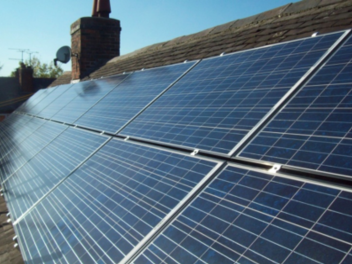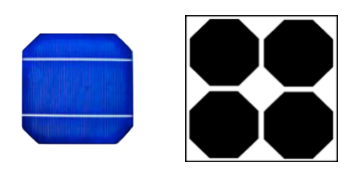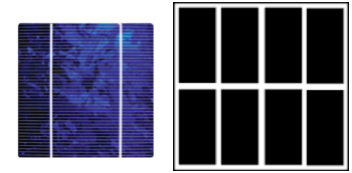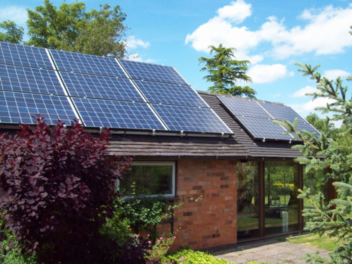
Sales people really go to town about which is the best type of solar panel and try to make out various reasons why their PV panels are best.
There are differences between the various types of panel, that are worth knowing about but, in the end, it is the total overall power that makes the biggest difference. A 3kW system will generate a very similar amount of electricity whether it is 3kW of poly, mono, thin film or hybrid panels. The “panel efficiency” quoted by manufacturers has very little bearing on the annual generation, it just affects how much roof space is needed for the same powered system read a full explanation of the meaning of panel efficiency.
My simple summary of the differences between panels would be:
Most crystalline modules (whether monocrystalline or polycrystalline) will perform in a very similar way in the UK and will take up roughly the same space on your roof. So, ignore the sales-speak and choose a manufacturer that you are confident in for the long term with good warranty terms and some proven history of quality and reliability and you will be fine.
Hybrid panels are definitely a cut above crystalline ones in terms of efficiency, which means that they generate a larger power from a smaller area. However, they are much too expensive compared to crystalline panels and are really not worthwhile, unless you have very limited roof space.
Thin film modules should, in theory, be the best for the UK climate, because they are very well suited to dull, diffuse conditions. They take up a lot more room than other types, but are
generally much cheaper. However, most distributors in the UK only stock crystalline modules, so take up of thin film in the UK is still quite small.
Black framed panels and even the latest “All Black” panels with black frames and black backing definitely have a better appearance than standard aluminium framed panels. They look particularly good on slate or dark colour plain tile roofs, but don’t make much difference on red or modern roofs. BUT.... black backed panels, in particular, will get a lot hotter, which will cause the solar cells to work less efficiently and you will generate less electricity. You will be paying more for the panels and generating less. So it is only worth fitting black backed panels if you are really concerned about the appearance of the panels and are prepared to accept that they won’t work as well as standard panels, eg if in you live in a conservation area.

The solar cells in monocrystalline panels are slices cut from pure drawn crystalline silicon bars. The entire cell is aligned in one direction, which means that when the sun is shining brightly on them at the correct angle, they are extremely efficient. So, these panels work best in bright sunshine with the sun shining directly on them. They have a uniform blacker colour because they are absorbing most of the light. Pure cells are octagonal, so there is unused space in the corners when lots of cells are made into a solar module. Mono mono panels are slightly smaller than poly panels for the same power, but this is only really noticeable on industrial scale installations where you may be able to fit a higher overall power with monocrystalline. These are the most efficient panels available, so they take up the least space on your roof.

The cost of producing pure silicon wafers is a little more than for polycrystalline cells but generally there is not much difference in price these days.

Polycrystalline panels are made up from the silicon offcuts, moulded to form blocks and create a cell made up of several bits of pure crystal. Because the individual crystals are not necessarily all perfectly aligned together and there are losses at the joints between them, they are not quite as efficient. However, this mis-alignment can help in some circumstances, because the cells work better from light at all angles, in low light, etc. For this reason, I would argue that polycrystalline is slightly better suited to the UK’s duller conditions, but the difference is marginal. The appearance is also different – you can see the random crystal arrangement and the panels look a little bluer as they reflect some of the light. Since they are cut into rectangular blocks, there is very little wasted space on the panel and you do not see the little diamonds that are typical of mono or hybrid panels. Some people prefer this more uniform appearance, others like the diamonds. The choice is yours because the overall size and cost is very similar to monocrystalline.
The main manufacturer of hybrid panels is Panasonic (formerly Sanyo). Their HIT module which has a thin layer of amorphous solar film behind the monocrystalline cells. The extra amorphous layer extracts even more energy from the available sunlight, particularly in low light conditions.
These are the most efficient panels available, so they take up the least space on your roof.
Unless you have a very small roof and want to extract the maximum amount of energy from it, we would not recommend using the hybrid panels at the moment. Hybrid panels are a lot more expensive than mono or poly-crystalline panels, so that the increase in energy produced does not justify the extra cost of buying them. Never choose hybrid panels if there is space on your roof to fit the same amount of power with crystalline panels, otherwise you will just be paying a lot more to generate the same amount of electricity
For some reason in our crazy UK market, many people are now offering completely black panels, not only with black frames, but also with a black backing behind the cells instead of the traditional white. It is true that these do give a much better appearance, particularly on slate roofs or old traditional cottages with dark coloured plain tiles.
However, the problem with having a black backing, is that black absorbs light and heat from the sun. this means that you do not get the extra benefit of some of the sunlight being reflected back onto the cells by the backing material. Also, the panels get hotter. Solar cells, like most electrical equipment, are more efficient when they are cooler, so that panels with black backs are always going to perform less effectively than ones with standard white backing.
If you are concerned about the appearance on your property, then we would recommend having a halfway house of using a panel with black anodised outer frame, instead of standard aluminium, but still have a white backing material. REC, as an example, have told us that they are not even going to produce a black backed module, because their main concern is always to try to improve the electricity that their PV panels generate and black backing is a retrograde step.

One of the best reports to look at is produced by a German Test Laboratory called Photon. They have a field of panels from a range of different manufacturers and carefully measure their outputs to find which produce the highest outputs over a year, measured in kWh / kW. You can read the latest Photon Test report here. Their tests over the last couple of years have consistently put manufacturers such as REC at the top for giving the highest annual output.
The report shows that if you put a 250W REC panel next to a 250W panel from most other manufacturers, it will produce at least 2-3% more electricity over a year. So, providing the REC panel is not much more expensive, it would be worth paying a little more to get the extra electricity. This is why we have primarily fitted REC panels over the last year or so. However, we are also now quoting a number of different Chinese manufactured panels. Although they may not produce as much electricity, they are cheaper than REC, so that overall you get a better return on your money and get better value from your solar panels.
a panel with the highest efficiency, thinking that surely the most efficient panels were the best. The problem is that what the manufacturers quote as their efficiency rating, is not particularly relevant in deciding the most cost effective option.
Solar panel efficiency is a measure of how much energy the panel produces per square meter. So, a more efficient 250 Watt panel will be smaller than a less efficient 250W panel and take up less space on your roof. However, in the end both will produce 250 watts of power. Panel efficiency is only really an issue if you are trying to squeeze the maximum possible electrical energy out of a particular roof space. You would then choose the most efficient available panel to fill your roof and extract every possible Watt of power from the available sunlight. However, more efficient panels, particularly the Panasonic (ex-Sanyo) hybrids, are a lot more expensive so that you may be paying a large amount extra for just a few extra units of electricity.
can never understand it when I drive past and see hybrid panels that only cover half the roof. The owners have been completely mis-sold a much more expensive system, in the belief that they will generate more because Sanyo/Panasoinc panels are “the best”. There would still have been space on the roof to fit standard mono or polycrystalline panels, which would generate the same amount of electricity, but for a much lower installation cost.
Most people are really trying to get the best possible value out of their roof space, in order to get the best return on their investment. Better, more useful measures of “efficiency” are:
1.Cost per kW – the cost per kilowatt of installed power.
2.kWh per kW - number of units of electricity (measured in kWh) generated per year per kilowatt of installed power
3 . Or even Cost per kWh – the overall price per unit of electricity generated over the lifetime of the system
If you compare one 4kW system, with another one, it is usually best to choose the one that costs you least, providing they are both going to be installed to the same standard. However, the cheapest panels do not always produce the most electricity so that sometimes it might be better to pay a little more for better quality panels that are proven to generate more electricity. One of the best reports to look at is produced by a German Test Laboratory called Photon. They have a field of panels from a range of different manufacturers and carefully measure their outputs to find which produce the highest outputs over a year, measured in kWh / kW. You can read the latest Photon Test report here. Their tests over the last couple of years have consistently put manufacturers such as REC at the top for giving the highest annual output. The report shows that if you put a 250W REC panel next to a 250W panel from most other manufacturers, it will produce at least 2-3% more electricity over a year. So, providing the REC panel is not much more expensive, it would be worth paying a little more to get the extra electricity. This is why we have primarily fitted REC panels over the last year or so. However, we are also now quoting a number of different Chinese manufactured panels. Although they may not produce as much electricity, they are cheaper than REC, so that overall you get a better return on your money and get better value from your solar panels.